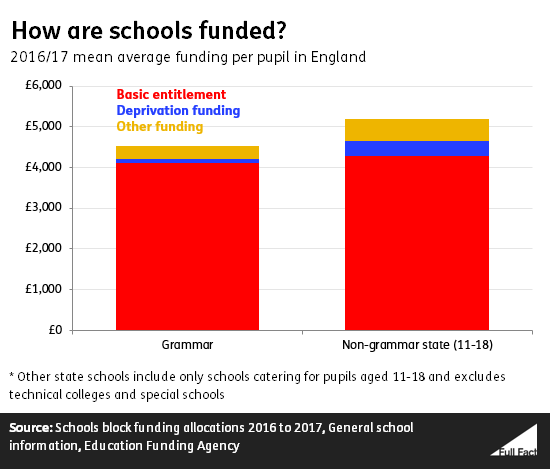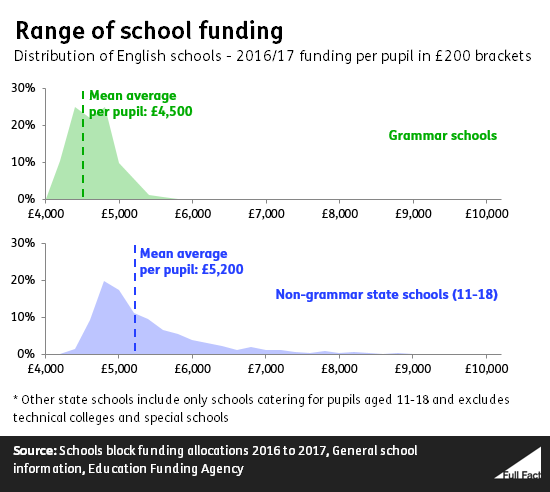What was claimed
Some grammar schools get less than £4,500 per pupil. Other state schools can receive as much as £8,000.
Our verdict
Correct. In 2016/17 English grammars received on average £4,500 per pupil while other state schools received £5,200.
Some grammar schools get less than £4,500 per pupil. Other state schools can receive as much as £8,000.
Correct. In 2016/17 English grammars received on average £4,500 per pupil while other state schools received £5,200.
“Many of the 163 grammars are facing a crisis under May, even though she promised to champion them. Some get less than £4,500 per pupil, among the lowest funding in the UK. Other state schools can receive as much as £8,000.”
The Sunday Times, 8 July 2018
It’s correct that around half of grammar schools in England received less than £4,500 per pupil in 2016/17. No grammar school received more than £5,500 per pupil.
Around 70 (or 5%) of the 1,500 non-grammar state schools taking students aged 11-18 received under £4,500 per pupil. A small number (21) received more than £8,000 per pupil.
On average, grammar schools in England received around £4,500 per pupil, while other state schools received £5,200.
It’s been reported that the new formula used to fund schools will boost grammar school budgets relatively more than other schools in coming years.
Honesty in public debate matters
You can help us take action – and get our regular free email
Grammar schools are selective state secondary schools found in England and Northern Ireland. There are 163 grammar schools in England, which the claim refers to, so we’ll focus on the schools there.
Schools get different kinds of funding. The vast majority of school funding comes from “basic entitlements”, with the rest coming from other grants such as those based on how deprived pupils at the school are.
Grammar schools and other state schools received similar levels of basic entitlement. In 2016/17 English grammar schools received an average of £4,100 a student, and other English state schools received £4,300.
Grammar schools however receive much less in other grants than other comparable state schools. For example, they receive about £250 per student less in deprivation funding, reflecting the fact that pupils in grammar schools are from relatively less disadvantaged backgrounds than pupils at other state schools
They also receive around £250 less in other funding sources.
For example, no grammar school received money for funding private finance initiatives (PFI) costs while around 100 other state schools did—as much as £2,100 per pupil in one school.

There is also a difference in the range of funding the different school types receive. While all grammars receive broadly similar funding per pupil (ranging from £4,100 to £5,400), non-grammar state schools can receive very different levels of funding per pupil (from £4,100 to £9,500).

We’ve excluded the “education services grant” from our calculations. This is given to academies to “cover the cost of the services that local authorities provide centrally to maintained schools but that academies must secure independently”. Including the grant for academies only would skew the overall data when trying to compare grammar schools with other schools.
We’ve also only included non-grammar state schools that take pupils of the same age range as grammar schools (11-18). This also excludes “all through” schools who offer primary and secondary education. We've also excluded special schools.
Finally we’ve used 2016/17 funding data rather than 2017/18 funding data. That’s because information about the types of schools (for example whether a school is a grammar or another type of state school) is only available from 2016/17.
School funding is allocated primarily based on each local council’s funding formula which means there are big differences in school funding between regions. You can view an interactive map here.

Once that is taken into account, grammar schools generally receive less funding than other state schools in the same area.
Of the 36 councils with grammar schools, only two put more money into pupils in grammar schools—£10 more per pupil in Essex and £32 more per pupil in Kirklees. The largest gap was in Slough where grammar schools received around £1,300 less per pupil on average than the other state schools in the area.
You can find an interactive map of the data here.
The reason why schools receive such different amounts is partly down to the individual characteristics of each school, but also down to how funding has been managed historically.
State-funded schools fall into two main groups: academies, where funding and oversight is directly from the Department for Education, and maintained schools, where funding and oversight is through councils,
Up until recently, the government has decided how much of the budget to hand over to each council, largely based on how much each council has received per pupil in previous years. In 2016/17, the year which the data above refers to, this was still the case.
Each council then uses a local funding formula to share this money out to local schools. They take into account several factors such as pupil numbers, deprivation, and prior attainment.
Although outside of the control of councils, the money used to fund academies and free schools is still calculated using the local funding formulas.
The Institute for Fiscal Studies, the Education Policy Institute (EPI) think tank, the government, and others have all said the old funding system is flawed and awards money inconsistently.
Part of this is intentional, the IFS has said, because of deliberate choices by the government to target funding towards disadvantaged schools and areas with higher costs.
But some variation has been more unintentional.
You can read more about how the school funding system works here.
Correction 3 August 2018
We've updated the graphs and article to clarify that special schools are excluded from the calculations.
Full Fact fights for good, reliable information in the media, online, and in politics.
Bad information ruins lives. It promotes hate, damages people’s health, and hurts democracy. You deserve better.